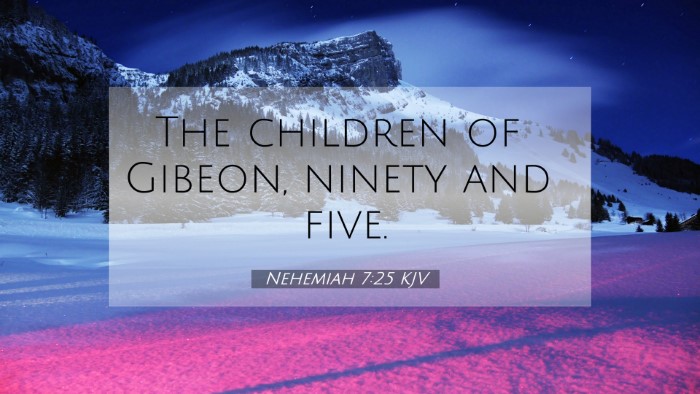Understanding Nehemiah 7:25
Verse: Nehemiah 7:25 - "The children of Ater of Hezekiah, ninety and eight."
This verse is a brief record of a section of the genealogical listings occurring in the book of Nehemiah, specifically detailing the descendants of certain families who returned from Babylonian captivity. The emphasis on numbers in the genealogies underscores the importance of acknowledging and maintaining proper lines of descent among the returned exiles.
Summary of Insights
The insights from public domain commentaries provide a well-rounded understanding of this scripture:
- Matthew Henry: Henry notes that this enumeration highlights the restoration of Israel’s identity post-exile. Families are counted to affirm their position in the covenant community.
- Albert Barnes: Barnes emphasizes the significance of maintaining genealogical records in ancient Israel. This allowed individuals to claim their rightful places in society and within the faith community.
- Adam Clarke: Clarke remarks on the historic aspect, viewing these lists as vital for the authenticity and legitimacy of the community’s formation after the return.
Thematic Connections
Nehemiah 7:25 connects with various themes in Scripture that highlight genealogy, restoration, and the significance of community within God's plan:
- The Importance of Genealogy: The genealogical records serve to validate the people's heritage and their identity as God's chosen. This is echoed in Matthew 1:1-17 which details the genealogy of Jesus, showing the importance of lineage in fulfilling prophecy.
- Community Restoration: Just as Nehemiah focuses on re-establishing the Jewish community, Ezra 2:1 lists returning exiles, reflecting a collective return to communal identity.
- Covenant Identity: Connection with Exodus 20:5-6 which discusses the generational promise of God and the blessings that flow to those who follow His commands.
Cross-References and Parallel Verses
Here are several Bible verses that relate closely to Nehemiah 7:25, showcasing the interconnectedness of biblical texts:
- Ezra 2:16: "The children of Adin, four hundred fifty and four." - Another listing of returned exiles, emphasizing the importance of families restored to their homeland.
- Nehemiah 12:1: "Now these are the priests and the Levites that went up with Zerubbabel..." - Indicates the line of priests and Levites which is essential for spiritual leadership in Israel.
- Luke 3:23-38: "Jesus, when he began his ministry, was about thirty years of age, being the son (as was supposed) of Joseph..." - A genealogy tracing back to Adam, reinforcing the continuity of God’s plan through generations.
- 1 Chronicles 9:1: "So all Israel were reckoned by genealogies..." - Similar theme demonstrating the importance of genealogical records in maintaining a connected community.
- Revelation 7:4: "And I heard the number of those who were sealed, a hundred and forty-four thousand..." - This eschatological vision indicates that God still values His people in terms of their spiritual heritage.
- Deuteronomy 30:5: "And the Lord thy God will bring thee into the land which thy fathers possessed..." - Connects the promise of return with lineage back to the patriarchs.
- Nehemiah 11:1: "And the rulers of the people dwelt at Jerusalem..." - Flows from the genealogical emphasis to practical living in the favored city of Jerusalem.
Practical Application and Reflection
This verse invites believers to reflect on their own spiritual lineage and community. It underscores how identity and heritage matter in the faith journey. Here are some ways to apply these insights:
- Understanding Your Heritage: Take time to explore your spiritual heritage—who are the mentors, teachers, or community members that have influenced your faith?
- Community Engagement: Just as the Israelites returned together, consider ways to actively engage in your local faith community.
- Preserving Your Identity: Like the lists in Nehemiah, be aware of how your identity in Christ relates to God's larger plan for people throughout history.
Conclusion
Nehemiah 7:25 serves as a reminder of the significance of genealogies in both historical context and spiritual meaning. Through cross-referencing with other scripture, we find richer layers of understanding about God’s persistent work in His people’s lives. The ties between different passages illustrate a tapestry of divine intention that spans generations, encouraging believers today to honor their spiritual lineage and engage with their community.



